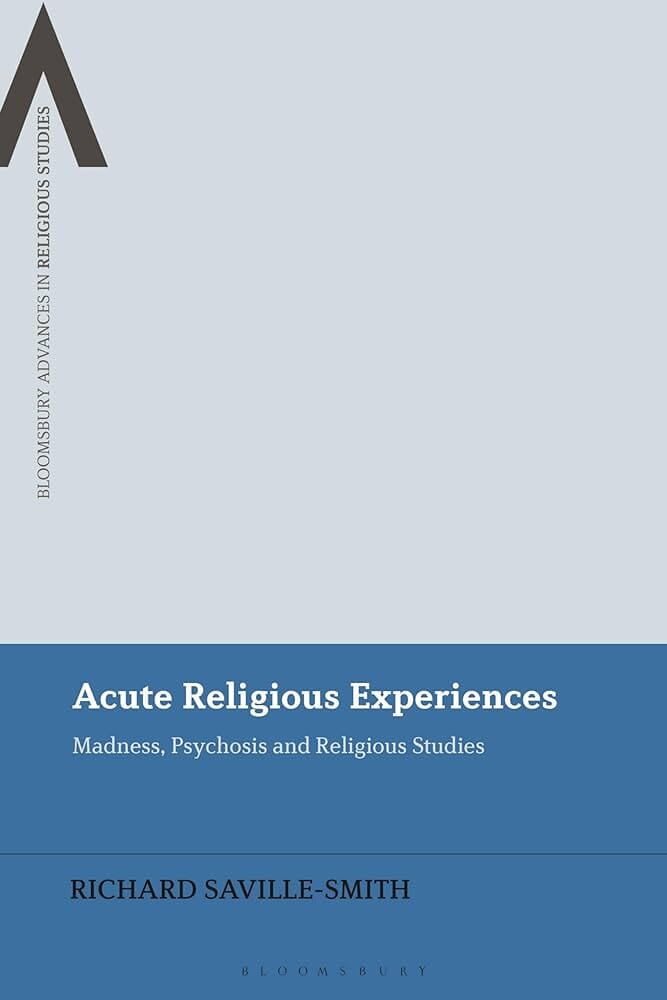Acute Religious Experiences: Madness, Psychosis and Religious Studies, Richard Saville-Smith

Review by Joshua Richardson
Richard Saville-Smith’s Acute Religious Experiences: Madness, Psychosis and Religious Studies is a mad book. I do not think the author will take offense to this description. After all Richard Saville-Smith is mad - he has the certificates, he tells his readers. The book’s madness is that it is from the standpoint of someone who is mad - and this perspective is one of the book’s central conceits. You see the author’s book is not only a contribution to religious studies as indicated by its title, but it also aims at furthering the endeavors of the newer, more nascent field of mad studies. Acute Religious Experiences is a paradoxical communion of madness and reason, fusing mad studies’ postmodern deconstruction with religious studies’ tradition rooted in the Age of Reason. It has another more worldly purpose perhaps in its core thesis arguing for acute religious experiences. Saville-Smith’s book is a challenge to the secularization of the soul in psychiatry and the human sciences, provoking the question: is there a distinction between religious experience and mental illness? Saville-Smith’s book argues that acute religious experience is one such a distinction.
The book argues its case over three parts: first in the context of religious experience, next in the context of mental illness, and lastly in a case study using a framework drawn from the work in the previous two sections. Saville-Smith carries readers through these sections with aplomb. The book’s prose is energetic with a wry wit, in a style that one might even call madcap. However, its style is never an added burden to the weight of the material; instead, it helps to balance the load. Saville-Smith also avoids the trappings of some postmodern stylists by choosing not to adopt their writing style. His writing is for the most part clear and vivid. Through reasoned argumentation and citation of the relevant literature, Saville-Smith builds his case using the techniques of religious studies descended from the Age of Reason. Yet, wherever reason sways in Acute Religious Experiences, madness is nearby. It is the author’s commitment to mad studies’ focus on the “contributions of madness within the human story” throughout the book which allows support for its main thesis, showing that madness is not merely reason’s antithesis, but it is also acute religious experience.
The first part begins with an examination of writing from an assortment of others on a disparate group of extraordinary, anomalous, and extreme experiences. Here Saville-Smith draws on his expertise in religious studies to show how acute religious experience provides a critical distinction from the conceptualizations of previous thinkers. From William James’ The Varieties of Religious Experience and Rudolf Otto’s The Idea of the Holy to Walter Pahnke’s Drugs and Mysticism and Abraham Maslow’s Religions, Values and Peak Experiences, alongside other authors, Saville-Smith argues that these authors’ conceptualizations either devalue, or exclude the contributions of madness. James’ pathological program devalues madness as a mystical experience. Otto’s concept of the numinous rationalizes the irrational. Pahnke’s psychedelic experience excludes psychosis. Maslow’s peak experiences exclude the ‘lower’ experiences of madness. Saville-Smith argues that this leaves room for a distinction between these ‘not necessarily pathological’ conceptions and acute religious experience. This is because, as he contends, acute religious experiences includes those extraordinary, anomalous, and extreme experiences devalued and excluded as irrational, psychotic, lower, and mad.
The second part of the book sustains its critique in the context of psychiatric diagnosis and the history of psychiatry. It is here that Saville-Smith draws most heavily upon the mad studies approach focusing on the contributions of madness and mad people. He argues that psychiatric diagnosis fails to make the distinction between acute religious experience and psychopathology; and as a result, it pathologizes extraordinary, anomalous, and extreme experiences. Saville-Smith focuses his critique upon the American Psychiatric Association’s Diagnostic and Statistical Manual (DSM-V). He then uses the History of Madness from Michel Foucault to contextualize the development of the DSM and its psychiatric constructs within the history of psychiatry. This is familiar territory for mad studies. However, Saville-Smith’s vision is far from familiar. He departs from Foucault, noting the famed French philosopher’s failure to engage fully with religion and madness in the Age of Reason. Saville-Smith also embraces the biological, which Foucault thwarts in his criticism of biopsychiatry. Where Foucault sees the machinations of power, Saville-Smith theorizes about the genetic heritage of madness and its contributions to culture. Not content to reiterate well-worn criticisms of psychiatric frameworks, Saville-Smith introduces his own model for acute religious experiences. The DREAD framework (Diversity, Religious, Extreme, Ambivalent, and Determination) is not a replacement or alternative to psychiatric diagnosis. It is a heuristic in a thought experiment aimed at discovering the utility, or disutility of the acute religious experience distinction. Saville-Smith does not leave it to the reader alone to determine if his distinction is worthwhile. In the next part of the book, he applies his framework in a case study in order to show the value of the acute religious experience distinction.
In the third and concluding part of his book, Saville-Smith uses his framework to assess the utility of his acute religious experience distinction in a case study of Jesus. This is not without precedent. Psychiatrists, philosophers, and theologians have all written pathographies of Jesus and other prophets; debating, diagnosing, and defending their sanity. Karl Jaspers, Sigmund Freud, and Paul Tillich are just some of the famous names to have ventured into such historical diagnostics. According to Saville-Smith the pathographies of Jesus which he examines fail - not because of any evidence (or lack thereof) for the historical Jesus - because their interpretations exclude and devalue the extraordinary, anomalous, and extreme experiences, which he argues are examples of acute religious experience. Saville-Smith focuses on Jesus’ baptism and subsequent venture into the wilderness alone for forty days and nights, along with the transfiguration, where Jesus’ disciples witness his transformation in an encounter with God and the prophets Moses and Elijah. These events provide ample evidence to satisfy the conditions set out by his DREAD model. Feeling custom fit, it is shown how they constitute diverse (D) expressions of experiences in the context of a religious (R) tradition, which are extreme (E) in nature, which also express a dualistic, or ambivalent (A) aspect (e.g. both Satan and God represented), within a determined (D) context. For Saville-Smith the results of his thought experiment are clear: the baptism and transfiguration of Jesus are clear examples of acute religious experience, thus showing the usefulness of the distinction.
Acute Religious Experiences works well as a criticism of the secularization of spirituality. It successfully shows how attempts to devalue and exclude madness from religious experience alongside psychiatry’s attempt to subsume it under diagnostic constructs continue the privileging of reason, which coincided, with the advent of secularization in the Age of Reason. As the UK, Europe, and North American societies have grown more secular, they continue to reinterpret their spiritual legacy through the lens of rationalization. Saville-Smith’s critique shows the value of what this lens filters out. However, the distinction of acute religious experience risks returning our interpretations of extraordinary, anomalous, and extreme experiences to the status of metaphysical dogma from which the Age of Reason had promised to liberate us. This is a common complaint made regarding aspects of postmodernity: it sees no objective truth and reduces everything to a solipsistic world of lived experience and subjectivity. It is not Saville-Smith’s criticism of religious studies and psychiatry, which commits this sin; rather, it is his interpretation of acute religious experiences as ‘intrinsically irrational’, which risks metaphysical dogma. Saville-Smith’s interpretation reiterates the image of madness as the absence of reason in this aspect, severing acute religious experience from the shared, intersubjective world enriched by common meanings - the common meanings which themselves serve to communicate religious traditions; all at the cost of an intractable paradox.
Acute Religious Experiences might be considered evidence of what some have described as an emerging ‘post-secular’ society in the West, where religion and religious experience are displacing the rationalizing forces of secularization. I think this would be a misreading of Saville-Smith’s book and Western society. Firstly, Saville-Smith gives clear reasons as to why he believes a differentiation between acute religious experience and religious experience should be made; this is because religious experience and other historical examples of thinkers of extraordinary, anomalous, and extreme experiences exclude and devalue experiences of the psychotic, or mad. Secondly, Saville-Smith’s defense of his interpretation of acute religious experience takes place in the context of a Western society and an academic tradition where it fulfills normative expectations of rationality in the defense of his interpretation of madness. Lastly, Saville-Smith’s rational defense of madness may leave an unsatisfying taste of paradox, but it comes at the price of reason, not revelation. Acute Religious Experience is not a post-secular defense of religion and religious experience, but a new, original interpretation for a secular age. I wonder if Saville-Smith would find this interpretation at all unreasonable?
Josh Richardson is a registered psychotherapist practicing in Ontario, Canada
Richard Saville-Smith. Acute Religious Experiences: Madness, Psychosis and Religious Studies (2023). Bloomsbury Publishing. 288 pages. More information.
